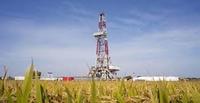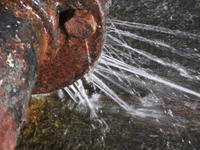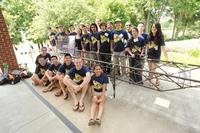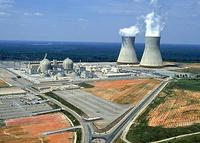-
NASA seeks ideas on locating and exploring asteroids – and redirecting them away from Earth

NASA also released a request for information (RFI) that invites industry and potential partners to offer ideas on accomplishing NASA’s goal to locate, redirect, and explore an asteroid, as well as find and plan for asteroid threats. The RFI is part of a broader NASA program focusing on finding all asteroid threats to human populations and knowing what to do about them.
-
-
New microfluidic chip useful in counterterrorism, water and food safety
A new process for making a three-dimensional microstructure that can be used in the analysis of cells could prove useful in counterterrorism measures and in water and food safety concerns. Researchers developed a new microfabrication technique to develop three-dimensional microfluidic devices in polymers. Microfluidics deals with the performance, control, and treatment of fluids that are constrained in some fashion.
-
-
An environmentally friendly battery made from wood
Taking inspiration from trees, scientists have developed a battery made from a sliver of wood coated with tin that shows promise for becoming a tiny, long-lasting, efficient and environmentally friendly energy source. Their report on the device — 1,000 times thinner than a sheet of paper — appears in the journal Nano Letters.
-
-
Shale oil and shale gas resources globally abundant: report
Estimated shale oil and shale gas resources in the United States and in 137 shale formations in forty-one other countries represent 10 percent of the world’s crude oil and 32 percent of the world’s natural gas technically recoverable resources, or those that can be produced using current technology. A new report estimates technically recoverable 345 billion barrels of world shale oil and 7,299 trillion cubic feet of world shale gas.
-
-
Testing the seismic strength of light frame steel construction
A partnership of leading earthquake engineering researchers from top U.S. and Canadian universities and design professionals from the steel industry have begun the final phase of a three-year project to increase the seismic safety of buildings that use lightweight cold-formed steel for their primary beams and columns. Research to conclude with shake-table testing.
-
-
Newark to raise water rates to pay for infrastructure

A report presented to Newark’s city council said that the town’s water and sewer rates will be increased by more than 60 percent over the next ten years in order to pay for $500 million in infrastructure repairs to the town’s faulty and outdated meters, century-old, leaky pipes, and broken valves.
-
-
Natural gas from fracking, coal have similar energy return on investment (EROI)
The value of a fuel’s long-term usefulness and viability is judged through its energy return on investment, that is, the comparison between the eventual fuel and the energy invested to create it. A new study finds that shale gas has a return value which is close to coal.
-
-
Risk assessment of shale gas fracking to biodiversity

Fracking, the controversial method of mining shale gas, is widespread across Pennsylvania, covering up to 280,000 km² of the Appalachian Basin. New research explores the risks posed to biodiversity including pollution from toxic chemicals, the building of well pads and pipelines, and changes to wetlands.
-
-
Texas to appeal FEMA decision not to declare West, Texas a disaster area
The Federal Emergency Management Agency (FEMA) said President Obama would not declare West, Texas a disaster area in the wake of the massive fertilizer plant explosion there two months ago, and Texas governor Rick Perry is not happy. FEMA said Texas did not make the case the state lacked funds for cleanup and recovery efforts.
-
-
New Jersey faces costly water infrastructure upgrades

Before Hurricane Sandy hit New Jersey, state officials knew they had much work ahead of them to update the state’s water infrastructure. The damage Sandy inflicted only highlighted the inadequacies of New Jersey’s outdated wastewater, stormwater, and drinking water infrastructure. Upgrading the system will be costly, but not doing so will be costlier.
-
-
U California, Berkeley students win National Student Steel Bridge Competition

The weekend of 31 May residents of Washington State watched as engineers began erecting a temporary steel bridge over the Skagit River, to replace the 160-foot span of a 4-lane bridge that had collapsed a week earlier, after being struck by an over-height truck. Just sixty miles away, on the campus of the University of Washington in Seattle, 620 civil engineering students erected their own temporary steel bridges in a competition to demonstrate their engineering skills. For the second consecutive year and for the second time in the past seven years, a team of students from the University of California, Berkeley captured the title as champions of the ASCE/AISC National Student Steel Bridge Competition (NSSBC).
-
-
Engineers on a wind load reconnaissance visit to tornado-hit Moore, Oklahoma
Eight days after an EF5 tornado struck Moore, Oklahoma, an 8-member team from the American Society of Civil Engineers’ (ASCE) Structural Engineering Institute (SEI) visited the area to assess the performance of critical facilities that either resisted or suffered significant damage from the estimated 200+ mph winds. The team studied four elementary schools and a hospital, and also examined the failures of long-span roof structures.
-
-
Increased U.S. crude oil production leads to dramatic fall in oil imports
The U.S. Energy Information Administration (EIA) issued its Annual Energy Outlook 2013 (AEO2013), which shows that under the assumption of crude oil production of about ten million bbl/d between 2020 and 2040 – which means total U.S. liquid fuels production (which includes crude oil, natural gas liquids (NGL), refinery gains, biofuels, and other liquid fuels) of more than eighteen million bbl/d in 2040 – net import of oil drops to 7 percent or less of total demand compared to 40 percent in 2012.
-
-
Israel taps 10th graders’ cybersecurity skills to expand cybersecuity recruitment pool
Israel has been subjected to a growing number of cyberattacks – and has itself used cyber-warfare against its adversaries. To make sure it stays ahead, Israel is accelerating its recruitment and development efforts in cybersecurity. Among other initiatives, the country is expanding the pool of potential cyberwarriors by going into high school classrooms to tap the cyber skills of tenth-graders.
-
-
Georgia’s Plant Vogtle may determine future of nuclear energy

Analysts say that the future of the U.S. nuclear industry, and of nuclear power generation in the United States, will largely depend on the success of two reactors, called Vogtle 3 and 4, at the Alvin Vogtle nuclear power plant in Georgia. For the nuclear industry, the Plant Vogtle project and another project in South Carolina may be the last hope of what many analysts consider to be a dying energy source.
-
More headlines
The long view
Helping Strengthen America’s Critical Infrastructure
Everyday life depends on a robust infrastructure network that provides access to running water, communications technology and electricity, among other basic necessities. The experts who keep our national infrastructure secure and resilient also need a strong network to share their knowledge and train the next generation of professionals capable of solving complex infrastructure challenges.
AI and the Future of the U.S. Electric Grid
Despite its age, the U.S. electric grid remains one of the great workhorses of modern life. Whether it can maintain that performance over the next few years may determine how well the U.S. competes in an AI-driven world.
Using Liquid Air for Grid-Scale Energy Storage
New research finds liquid air energy storage could be the lowest-cost option for ensuring a continuous power supply on a future grid dominated by carbon-free but intermittent sources of electricity.
Enhanced Geothermal Systems: A Promising Source of Round-the-Clock Energy
With its capacity to provide 24/7 power, many are warming up to the prospect of geothermal energy. Scientists are currently working to advance human-made reservoirs in Earth’s deep subsurface to stimulate the activity that exists within natural geothermal systems.
Experts Discuss Geothermal Potential
Geothermal energy harnesses the heat from within Earth—the term comes from the Greek words geo (earth) and therme (heat). It is an energy source that has the potential to power all our energy needs for billions of years.
